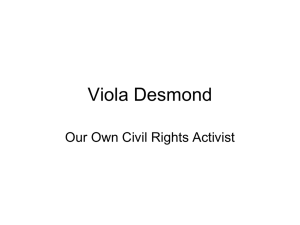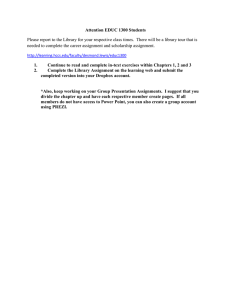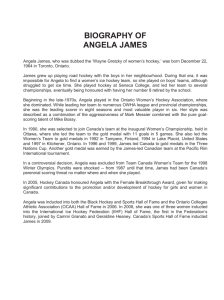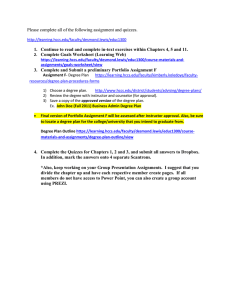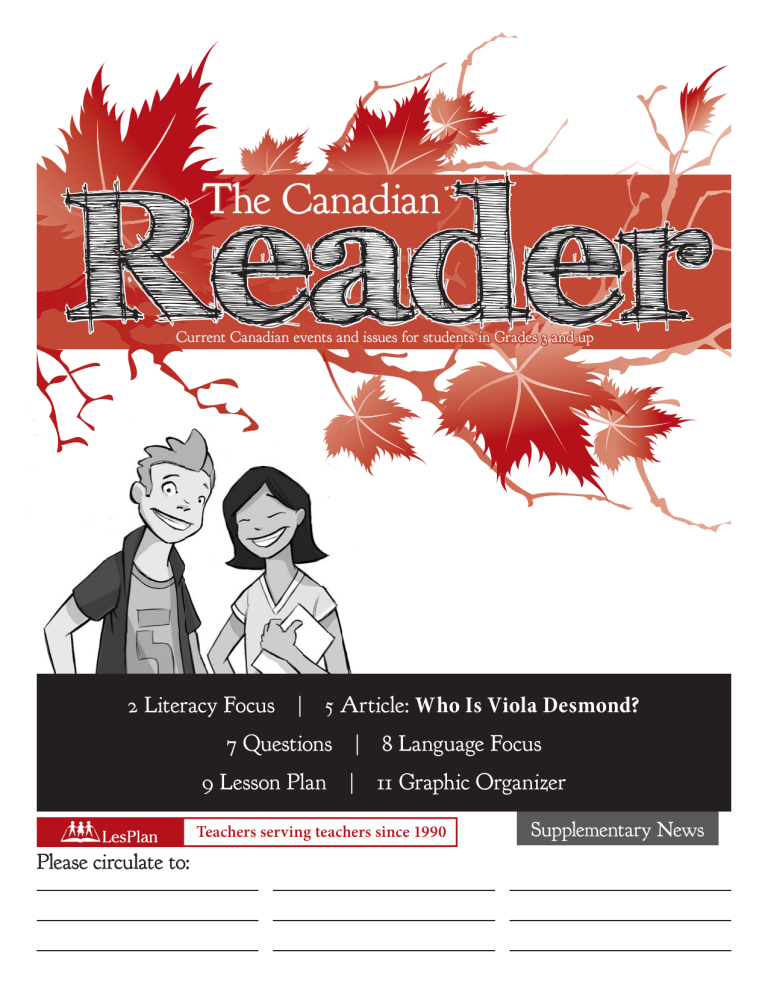
Reader The Canadian Current Canadian events and issues for students in Grades 3 and up 2 Literacy Focus | 5 Article: Who Is Viola Desmond? 7 Questions 9 Lesson Plan | | 8 Language Focus 11 Graphic Organizer Teachers serving teachers since 1990 Please circulate to: Supplementary News Literacy Focus Inferring: Teaching Strategy Introduction: Show students a picture of a person displaying an obvious emotion, such as happiness, sorrow, or fear. Ask them what this person is feeling. Then, ask students how they know. Explain to students that they used a visual clue – a facial expression – to infer what the person was feeling. Can students infer why the person in the photo might be feeling this way? Explain to students that Inferring is another key reading strategy. Inferring means using facts – the things we see and observe – to make an interpretation. Use the Inferring Student Handout (p. 4) to introduce students to this strategy. To reinforce the concept of inferring, involve the class in a game. First, brainstorm with students a list of emotions; record these on chart paper for everyone to refer to. Then, ask one student to leave the room. With the class, choose one emotion. Invite the absent student back into the room. Have the other students help him or her 'infer' the chosen emotion by giving clues. Clues must begin with "I felt this way when..." For example, if the emotion is 'jealous', the clue given could be "I felt this way when my baby sister was born and everyone paid attention to her instead of to me." When the emotion has been correctly inferred, invite a new student to leave the room and repeat the game. Modeling: Choose one article from this issue to use to model Inferring. Read this story to students while they follow along. As you read, pause to record key facts or quotes in the left-hand 'Facts' column of the Three-Column Chart (p. 5). After recording each fact, write a question about this fact in the middle 'Questions' column of the chart. Begin your question with "I wonder...". Then, record a possible answer to your question in the right-hand 'Inferences' column. Beginning each inference with the phrase "I think..." or "Maybe..." will help reinforce the idea that when you make an inference, you are offering your own ideas about what the author has written. Guided Practice: Choose a second article. Read this story together with the class. Pause after each paragraph or section and ask students to comment on this text. What interesting or important facts or quotes jumped out at them? Record these facts or quotes in the 'Facts' column of the chart. Then, ask students what they wonder about this information. Record their questions in the middle column. Finally, invite students to suggest possible answers to the question. Record their inferences in the right-hand column. Remind students that a good inference helps the reader to better understand the text and is fully explained. Independent Practice: Distribute a copy of a third article and Three-Column Chart to each student. Then, have students independently read the selection, recording facts and inferences on their organizer. When finished, students can share their chart with a partner. Then, engage students in a class discussion: In what ways are partners' charts similar? In what ways are they different? How can partners account for these similarities and differences? In what ways can inferring help students better understand what they read? Sources: Gear, Adrienne, Reading Power, Pembroke Publishers, c. 2006; Harvey, Stephanie and Goudvis, Anne, Strategies that Work, Pembroke Publishers, c. 2000; Stead, Tony, Is That a Fact?, Stenhouse Publishers, c. 2002. 2 The Canadian Reader Supplementary News Literacy Focus Inferring Good readers infer while they read. In their heads they fill in, using their experiences and background knowledge, what is not written or shown on the page. When you make an inference . . . . . . you read betw een the lines. You re ad what is on the page , and then you interpret what the author is sayin g. Predicting is one kind of inference. When you make a prediction, you're using clues to help you infer what might happen in the future. ook . . . you are a b u hunt for detective. Yo you figure clues, and then ight mean. out what they m . . . you are mak in g an 'educated guess .' In science, educated gu esses – or inferences – ar e called 'hypotheses.' 3 The Canadian Reader Supplementary News Name: Date: Article/Comic title: Literacy Focus Three-Column Chart Text 4 Questions Inferences (I wonder...) (Maybe... / I think...) The Canadian Reader Supplementary News Who Is Viola Desmond? The year was 1946. Viola Desmond was in New Glasgow, Nova Scotia. Her car had broken down. While waiting to have it fixed, she went to a movie theatre. That decision changed her life. No blacks allowed Ms. Desmond was a business woman. She ran a beauty salon in Halifax. She also happened to be a black woman. The New Glasgow movie theatre was segregated. That meant black people could only sit in the balcony. Floor seats downstairs were for whites only. Ms. Desmond wanted to sit close to the screen. She was short, and her eyesight wasn’t very good. She tried to buy a floor seat, but was refused. So she bought a seat in the balcony. It was one cent cheaper. Then she sat in the whites-only area anyway. She settled into a seat. 5 Theatre staff called the police. They dragged Ms. Desmond out of the theatre. She spent 12 hours in jail. Charged... and found guilty Viola Desmond was charged with paying for a balcony seat that cost one penny less than the one she actually sat in. Her fine was $26. She decided to challenge it. This was the first time that a black woman in Canada had challenged laws that were unfair to black people. She fought all the way to the highest court in Nova Scotia. In the end she lost the case. Yet she inspired generations of black people to stand up for their rights. The Canadian Reader Supplementary News A powerful symbol “Every time somebody... pulls out a $10 bill, there will be an African-Nova Scotian gracing the face of that bill,” said one black activist. “That’s amazing. That’s almost unbelievable.” Ms. Desmond died in 1965. Fortyfive years after her death, she was pardoned for her ‘crime.’ Today, we are appalled by the idea of a segregated movie theater. There are laws against treating someone differently due to their skin colour. A proud sister Some 461 women were suggested by the public for this honour. There were five finalists. Poet Pauline Johnson. Electrical engineer Elsie MacGill. Quebec suffragette Idola Saint-Jean. Olympic medalist Fanny Rosenfeld. And Viola Desmond. Yet despite these laws, black people in Canada still sometimes face discrimination. Ms. Desmond’s fight A suff ragette is a is not over. woman who took part in public protests about giving women the right to vote in the early 1900s. That’s why she is a powerful symbol. It’s also why she has been chosen to be on the face of Canada’s new $10 bill. Except for the Queen, Viola Desmond is the first woman – and the first black person – to have that honour. 6 Ms. Desmond’s sister, now 89, was at the December 8th announcement. “It’s a big day to have a woman on a bank note,” she said. “But it’s an especially big day to have your big sister on a bank note.” The Canadian Reader n't sit YOU could … if t a h e of W ted becaus n a w u o y where in? of your sk r u lo o c e th Supplementary News Name: Date: Who Is Viola Desmond? Comprehension Check Answer the questions below in complete sentences: 1. Who is Viola Desmond? 2. What does it mean when a movie theatre is 'segregated'? 3. Why did Viola Desmond want a floor seat at the movie theatre? 4. What happened when Ms. Desmond refused to leave her seat? Why? 7 The Canadian Reader Supplementary News Name: Date: Who Is Viola Desmond? Language Focus Match each word from the list below with its correct definition: segregate appalled honour challenge pardon discrimination feature inspire 1. offended or shocked 2. to officially forgive someone for committing a crime 3. to be an important part or aspect of something 4. to question whether something is true, accurate, or legal 5. to separate groups of people because of race 6. to show great respect towards something 7. to give someone the enthusiasm to do or create something 8. unfair treatment of someone because of their religion or race 8 The Canadian Reader Supplementary News Who Is Viola Desmond? Lesson Plan Before Reading: Project, using appropriate technology, images of the current series of Canadian polymer banknotes, found at http://www.bankofcanada.ca/banknotes/bank-note-series/polymer/design/ Explore two or more of the bills, pointing out the shared and unique design elements, portraits, themes, images, and symbols. Discuss the significance of each and how they reflect Canada. Then, read the title of the article aloud and project a picture of Viola Desmond, such as the one found at https://heritageday.novascotia.ca/sites/default/files/inline/images/viola_ desmond_700x400_with_name.jpg Invite students to predict why she might have been selected to appear on the new $10 bill (why she’s important and how she might reflect Canada). Record their thinking on chart paper. During Reading: As they read, encourage students to look for information that confirms, adds on to or helps them revise their predictions about Viola Desmond and the decision to feature her on the new $10 bill. After Reading: Using a Think-Pair-Share discussion structure, ask partners to talk about their predictions and findings. As a class, review the Bank of Canada’s criteria for selecting and designing bank note series (pay close attention to how they ‘Reflect Canada’): http://www.bankofcanada.ca/banknotes/ principles-bank-note-design/ You may wish to record these for reference. Distribute to each student, or pairs of students, a copy of What’s Important? Why? (p .12). Direct students to reread the article and to record important facts (aim for at least one fact under each heading) about Ms. Desmond and the Bank of Canada’s decision to feature her on the new bill. Model, using the introduction, how to complete the T-chart: What's important? • in 1946, Viola Desmond's car broke down in Nova Scotia so she decided to see a movie while waiting to have it fixed Why? • if the car had not broken down, she may not have decided to go to the movie and, therefore, would not have been arrested When students have finished their charts, have them complete a 5-10 minute Quick Write reflecting on why Viola Desmond was a powerful symbol and a good choice to be on the new $10 bill. Alternatively, encourage them to explain how she reflects Canada, according to the Bank of Canada’s criteria. Criteria for Assessment: A thoughtful reflection is clearly written; provides sufficient, relevant evidence; offers logical conclusions; and shows insight into the issue. Extension: Option #1: Students may wish to learn about the other four finalists and compare their profiles against the Bank of Canada’s criteria to determine the extent to which they would have been good choices (a very good choice, a somewhat good choice), too, and why. 9 The Canadian Reader Supplementary News Who Is Viola Desmond? Lesson Plan Option #2: Have students research Viola Desmond using the links below. Have them summarize their findings in a biopoem or design the new $10 bill (including images and/or symbols that would represent Ms. Desmond’s life, her legacy, rights and/or racial discrimination in Canada). [IRA’s ReadWriteThink has a handout entitled ‘How to Write a Biopoem’ that provides a template and an example of a completed biopoem. The example poem is about Rosa Parks so students could also compare the lives of both civil rights leaders. You can download the handout at http://www.readwritethink.org/files/resources/lesson_images/lesson398/biopoem.pdf] Internet Connections: To read more about this news story, go to: https://www.thestar.com/opinion/editorials/2016/12/10/putting-viola-desmond-on-the-10-billis-a-powerful-symbol-editorial.html https://www.thestar.com/news/gta/2016/12/11/viola-desmond-reminds-us-that-while-you-maynot-taste-victory-the-fight-is-still-worthy-keenan.html Learn more about Viola Desmond on these Heritage Minute links: Heritage Minute: https://youtu.be/ie0xWYRSX7Y [1:00] Heritage Minute (behind the scenes): https://youtu.be/9GZn1QdhafM [3:45] https://www.historicacanada.ca/content/heritage-minutes/viola-desmond Watch a documentary of Viola Desmond's life: Long Road to Justice: The Viola Desmond Story: https://youtu.be/yI00i9BtsQ8 [44:24] See other tributes to Viola Desmond: Someday - Wanda Robson honours her sister, Civil Rights icon Viola Desmond: https://youtu.be/QEK0ZbI3exc [1:56] Halifax ferry named after civil rights activist Viola Desmond: https://youtu.be/svjJNVf3n3U [2:06] Viola Desmond (dramatization by Black Halifax): https://youtu.be/qYSqTa0KtLE [5:09] Being Black in Canada: http://www.cbc.ca/player/play/2683118433/ [5:52] Nova Scotia Heritage Day - Viola Desmond: https://youtu.be/B0r_4NpWTr8 [5:34] Michie Mee Teaches Us Something About Viola Desmond's Stand Against Segregation: https://youtu.be/lSl0yCbVEgQ [0:52] Viola Desmond: An Unlikely Crusader: https://youtu.be/a9zQ5bNyn8s [3:14] http://www.cbc.ca/news/canada/viola-desmond-wanda-robson-black-history-month-1.3430629 Look at the stamp honouring Viola Desmond: https://tce-live2.s3.amazonaws.com/media/media/7abdf3b1-3830-4cc7-830f-c7028d67903f.jpg Read newspaper articles from 1946 about Ms. Desmond’s arrest and court rulings: https://tce-live2.s3.amazonaws.com/media/media/6c4e23cf-09b1-494b-b99f-0eea6957d0ee.jpg https://novascotia.ca/archives/images/Desmond/201501078.jpg See an artist’s version of the new $10 bill: http://www.heroines.ca/graphics/desmondnote.jpg Note: All URLs are posted as links at http://www.lesplan.com/en/links 10 The Canadian Reader Supplementary News Name: Date: Who Is Viola Desmond? What's Important? Why? What's important? Why? No blacks allowed Charged… and found guilty A powerful symbol A proud sister 11 The Canadian Reader Supplementary News Current Events, Clearly Explained Students want to know what’s happening in their world – but the news can be difficult and time-consuming to teach. 5 & up Print or pdf grade grade 3 & up We have the solution. (Three, actually.) Rick Han sen Many in otion ManM y in Mot Rick Hansen andion Th Many in e Economy Motion The Econom and Level Rick Han sen and Europe , the Europe, the U.S., Level 2 2 (Gra des 8, (Grades 8, 9 and Level 2 (Grades 8, 9 and 10) 9 and e3 grad 10) 10) page 3 p &u U.S., and page 3 and page 14 page 3 for Sur vival in page 14 Struggle y Somalia ma Celia ll Europe, the U.S., and Struggle for Survi val in TheSo Economy page 9 page 14 Ph page ones in the Spo Struggle for Survival in tlig9 Cell Phon ht Somalia es in the page 20 page 9 Spotlight Routing 20 Slip: page (pleas Cell Phones in theg Slip: Spotlight Routin e circul ate) A mon thly curre nt even ts resou Septemb er 2011 rce for Canadian A month September classroom ly curren 2011 t events resour s ce for Canad September ian 2011 classrooms A monthly current events resource for Canadian classrooms (please circulate page 20 ) Online interactive Routing Slip: (please circulate) The Canadian Reader Nos Nouvelles What in the World? Le Monde en Marche Currents4Kids.com Infos-Jeunes.com 9 Print/pdf resource 9 Print/pdf resource 9 Online interactive resource 9 Clearly written, leveled Canadian current events articles 9 National and international news stories 9 Weekly news stories 9 Literacy-based lesson plans 9 Key vocabulary 9 Engaging, original illustrations 9 Background information 9 Comment page for students to respond to the stories 9 Comics 9 Varied assignments that build content-area knowledge and enhance critical thinking 9 Map assignments Product details: 32 pages, black and white. Available in English and in French for grades 3 and up. 9 Autograded quizzes 9 Links to relevant articles, resources, maps, photos and videos 9 Suggested activities and a Word Work assignment 9 Maps and illustrations Product details: 32 pages, black and white. Available in English and in French, and in two reading levels, for grades 5 and up. One subscription allows all teachers and students access to this site from any Internet-connected device at any time. Available in English and in French, for grades 3 and up. 1-888-240-2212 lesplan Contact us for a sample copy or free demo. www. .com LesPlan Educational Services Ltd. #1 - 4144 Wilkinson Road, Victoria, BC V8Z 5A7 Email: info@lesplan.com to Order Teachers Serving Teachers Since 1990 EMail info@lesplan.com Fax (toll free) 1-888-240-2246 Call (toll free) 1-888-240-2212 Name The Canadian Reader / Nos Nouvelles ($) Amount 4 issues (Feb. - May) School Address English $95.00 City Français 95.00 $ School District What in the World? / Le Monde en Marche 4 issues Level 1 Phone ($) Amount (Feb. - May) Grades 5 and up Prov. ( Attention Français 95.00 $ School District 4 issues English $95.00 Français 95.00 $ 5 months English $95.00 Français 95.00 $ Prov. Postal Code Bill school PO# __________ Visa MasterCard Currents4Kids / Infos-Jeunes (Feb. - June) City Payment Options Online Interactive Subscriptions Grades 3 and up PO# Address ($) Amount (Feb. - May) Grades 8 and up JSame as above Bill To $95.00 What in the World? / Le Monde en Marche Postal Code ) English Level 2 LesPlan Educational Services Ltd #1 - 4144 Wilkinson Road Victoria BC V8Z 5A7 Deliver To Print/PDF Subscriptions Grades 3 and up Mail Card # ($) Amount Expiry Date Name on Card ** LesPlan Office Use 2016 - 2017 ** print/pdf delivery method Canada Post or Internet* *E-mail required for password notification (please print) Sub total NB, NL, NS and PEI add 15% HST ON add 13% HST Paid GST / HST all others add 5% GST ------ Excel Visa MC Cheque ____________ Bill School Purchase Order total To order or for more information, please go online I-J / C4K ______________ Invoice # __________________ www.lesplan.com or call (toll free) 1-888-240-2212 VD 150
